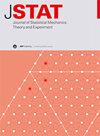A modified social force model considering collision avoidance based on empirical studies
IF 1.9
3区 物理与天体物理
Q2 MECHANICS
Journal of Statistical Mechanics: Theory and Experiment
Pub Date : 2024-08-20
DOI:10.1088/1742-5468/ad65e4
引用次数: 0
基于实证研究的考虑避撞的修正社会力模型
摘要避免行人之间的碰撞不仅仅是基于几何方法,还涉及人类的社会习俗。以往的行人避撞模型往往忽视了个人空间和入侵者入侵变化的重要性,如入侵角度、入侵范围和危险程度。行人的避撞行为受其初始位置到入侵者路径交叉点的相对位置、移动方向和距离的影响。为了建立和校准行人回避模型,我们在不同条件下对动态和静态入侵者进行了虚拟现实和现实实验。实验分析了临界避让边界、避让过程函数和避让侧概率。通过对比分析,确定了避让所需的个人空间和几何空间之间的差异。此外,本研究还在社会力模型中加入了根据运动学约束和入侵者相对位置计算转向角的避让模型。该模型成功地再现了行人在面对静态和动态入侵者时的避让行为,为在高度竞争的空间环境中处理复杂的行人运动提供了有价值的工具。
本文章由计算机程序翻译,如有差异,请以英文原文为准。
求助全文
约1分钟内获得全文
求助全文
来源期刊
CiteScore
4.50
自引率
12.50%
发文量
210
审稿时长
1.0 months
期刊介绍:
JSTAT is targeted to a broad community interested in different aspects of statistical physics, which are roughly defined by the fields represented in the conferences called ''Statistical Physics''. Submissions from experimentalists working on all the topics which have some ''connection to statistical physics are also strongly encouraged.
The journal covers different topics which correspond to the following keyword sections.
1. Quantum statistical physics, condensed matter, integrable systems
Scientific Directors: Eduardo Fradkin and Giuseppe Mussardo
2. Classical statistical mechanics, equilibrium and non-equilibrium
Scientific Directors: David Mukamel, Matteo Marsili and Giuseppe Mussardo
3. Disordered systems, classical and quantum
Scientific Directors: Eduardo Fradkin and Riccardo Zecchina
4. Interdisciplinary statistical mechanics
Scientific Directors: Matteo Marsili and Riccardo Zecchina
5. Biological modelling and information
Scientific Directors: Matteo Marsili, William Bialek and Riccardo Zecchina

 求助内容:
求助内容: 应助结果提醒方式:
应助结果提醒方式:


